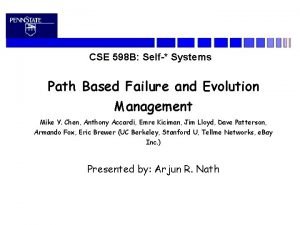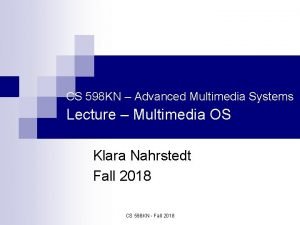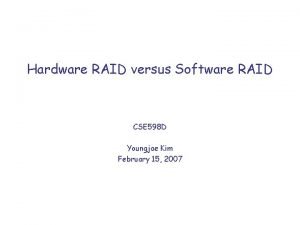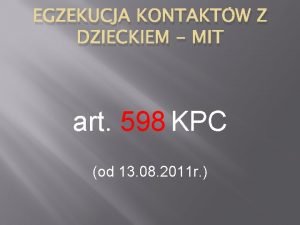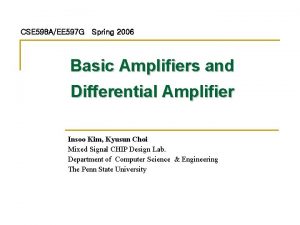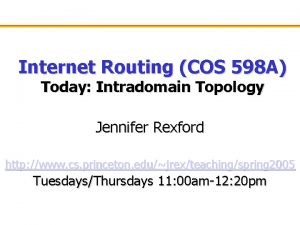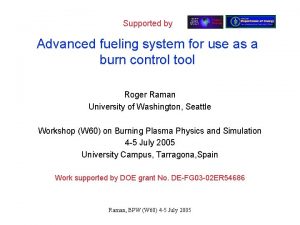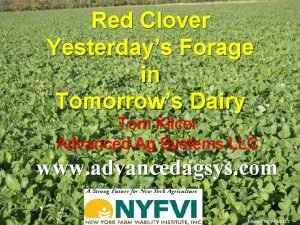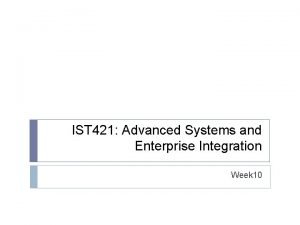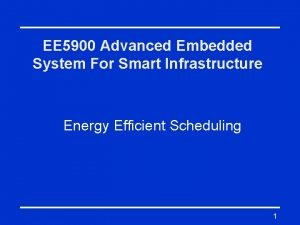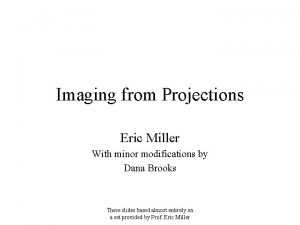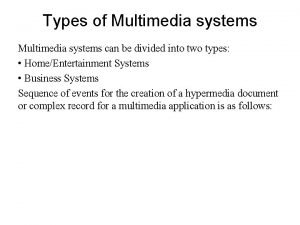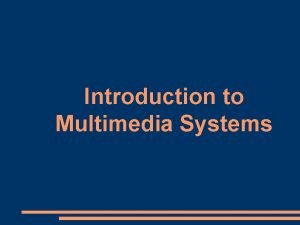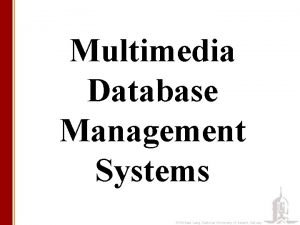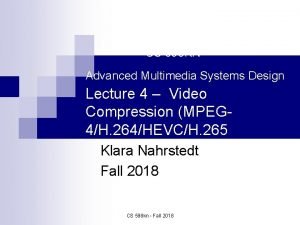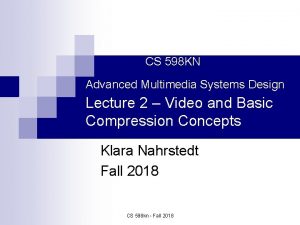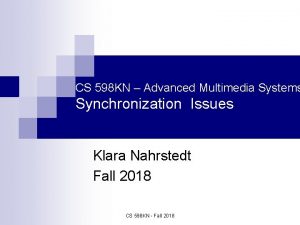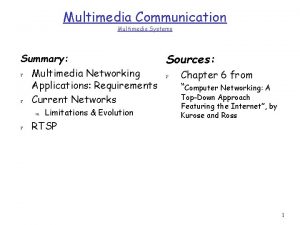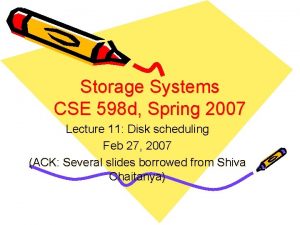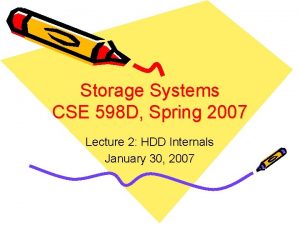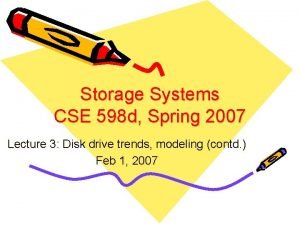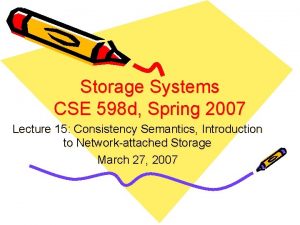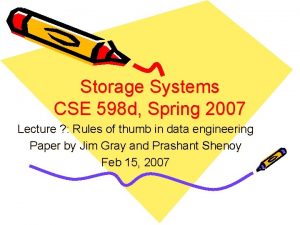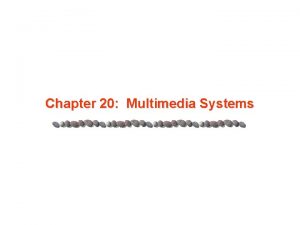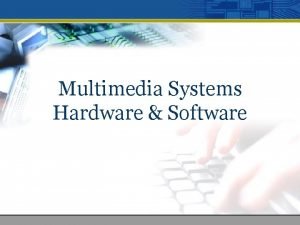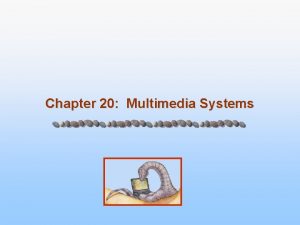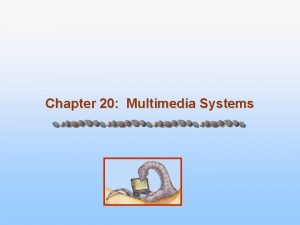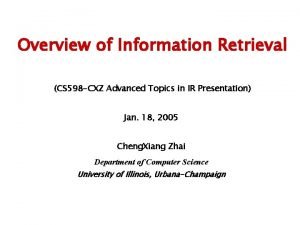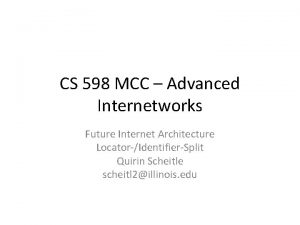CS 598 KN Advanced Multimedia Systems Lecture Multimedia











































- Slides: 43

CS 598 KN – Advanced Multimedia Systems Lecture – Multimedia OS Klara Nahrstedt Fall 2018 CS 598 KN - Fall 2018

Covered Aspects of Multimedia OS in each multimedia device Audio/Video Presentation Audio/Video Playback Perception/ Playback Image/Video Capture Image/Video Information Representation Transmission Audio Capture Transmission Compression Processing Audio Information Representation Media Server Storage CS 598 KN - Fall 2018 A/V Playback

CPU Process/Thread Scheduling Maintain many programs in memory n Determine how to best schedule them n Requires information about the processes and an understanding of the system goals n Switch among processes rapidly so each user perceives direct ownership of system n CS 598 KN - Fall 2018

CPU Scheduling Evaluation Criteria n Throughput: processes completed per unit time Turnaround: from submission to termination Wait: time waiting in the ready queue Response: from user request to system response Utilization: how busy the CPU is over time n Want predictable system behavior n n CS 598 KN - Fall 2018

Scheduling Algorithms FCFS n Shortest Job First n Priority scheduling n Round-robin n Multi-level queue n For General Purpose Process CPU Scheduling Rate monotonic n Earliest deadline first n CS 598 KN - Fall 2018 For RT/Multimedia Process CPU Scheduling

Real-time/Multimedia Processing Requirements n Need to process continuous multimedia data ¨ Processing occurs in predetermined, usually periodic intervals ¨ Processing must be completed by certain deadlines n Need RT process manager ¨ Perform admission control ¨ Determine schedule ¨ Perform reservation ¨ Schedule to give processing guarantees CS 598 KN - Fall 2018

RT/Multimedia Processing Requirements Main Problem: How to find a feasible schedule? n Conflicting Goals/Problems: n How do we schedule multimedia (RT) processes so that n non-RT processes do not starve when RT process is running 2. RT process is not subject to priority inversion 1. CS 598 KN - Fall 2018

Model in RT Scheduling n n Task (Process) – schedulable unit Task characterized by Timing constraints ¨ Resource requirements ¨ n Assumptions ¨ n Periodic tasks without precedence relations Time constraints s – task starting point ¨ e – task processing time ¨ d – task deadline ¨ p – task period ¨ CS 598 KN - Fall 2018

Periodic Constant Processing Time Tasks n Example Usage Pattern: Peak Processing Time=10 ms Period = 100 ms 0 10 100 110 200 210 Time(ms) CS 598 KN - Fall 2018

Periodic Variable Processing Time Tasks n Example Usage Pattern: Period = 100 ms Peak Processing Time = 30 ms Sustainable Processing Time = 15 ms Burst Tolerance = 7 ms 0 15 100 120200210 Time(ms) CS 598 KN - Fall 2018

Model of RT Scheduling n Congestion avoidance deadline ¨ If period at (k-1) step is equal to ready (start) time of period k n n Tasks: preemptive vs. non-preemptive Main goal of RT Scheduling: ¨ find feasible schedule of all periodic tasks so that newly arriving task and all previous admitted tasks finish processing in every period according to their deadline CS 598 KN - Fall 2018

Model of RT Scheduling Must have Schedulability (Admission) Test for RT tasks n What is the performance metric for RT tasks? n ¨ Guarantee ratio : = number of guaranteed tasks/total number of tasks ¨ Process utilization (U): CS 598 KN - Fall 2018

Scheduling Policies of RT Tasks n Rate- Monotonic Scheduling (RMS) ¨ Designed/proved by C. L. Liu and Layland 1973 ¨ Policy: task with highest rate has highest priority ¨ Static and optimal, priority-driven n n Optimal means that there no other static algorithm that is able to schedule a RT task which can’t be scheduled by RMS algorithm Assumptions: ¨ ¨ ¨ Tasks are periodic Each task must complete before next request All tasks are independent Run-time of each task request is constant Any non-periodic task has no required deadline CS 598 KN - Fall 2018

Example of RMS CS 598 KN - Fall 2018

Scheduling Policies for RT Tasks n Earliest Deadline First (EDF) Policy ¨ Optimal dynamic algorithm ¨ Produces valid schedule if one exists ¨ Complexity O(n 2) ¨ Upper bound of process utilization 100% ¨ Policy: task with earliest deadline has highest priority CS 598 KN - Fall 2018

Example of EDF CS 598 KN - Fall 2018

Comparison between RMS and EDF CS 598 KN - Fall 2018

Admission Control (for preemptive tasks) n Schedulability test for RMS n Schedulability test for EDF CS 598 KN - Fall 2018

Example n Consider the following preemptive RT tasks and their characteristics ¨ T 1: p 1 = 50 ms, e 1=10 ms ¨ T 2: p 2 = 100 ms, e 2=20 ms ¨ T 3: p 3 = 200 ms, e 3=50 ms ¨ T 4: p 4 = 100 ms, e 4=20 ms n Are these tasks schedulable via RMS? ¨ If n yes, what is the feasible schedule? Are these tasks schedulable via EDF? ¨ If yes, what is the feasible schedule? CS 598 KN - Fall 2018

MULTI-CLASS AND HIERARCHICAL SCHEDULING FOR MULTIMEDIA CS 598 KN - Fall 2018

DSRT (Dynamic Soft Real-Time Scheduling) – Example of a Multimedia CPU Scheduler n Multiple CPU Service Classes ¨ Schedule real-time and not real-time tasks in an integrated fashion Execution Flow of a SRT Process n Possible Mapping CPU Service Classes into a Multiprocessor Partitioning Design n CS 598 KN - Fall 2018

CPU Service Classes Specification Parameters PCPT (Periodic Constant Processing Time) P = Period PPT = Peak Processing Time PPT PVPT (Periodic Variable Processing Time) P = Period SPT = Sustainable Processing Time PPT = Peak Processing Time BT = Burst Tolerance SPT ACPU (Aperiodic Constant Processor Utilization) PPU = Peak Processor Utilization PPU Event Relative Deadline PPTCS =598 KN Peak- Fall Processing Time 2018 Guaranteed PPT

Periodic Constant Processing Time Class n Example Usage Pattern: Peak Processing Time=10 ms Period = 100 ms 0 10 100 110 200 210 Time(ms) Processing IIIIII frames CS 598 KN - Fall 2018

Periodic Variable Processing Time Class n Example Usage Pattern: Period = 100 ms Peak Processing Time = 30 ms Sustainable Processing Time = 15 ms Burst Tolerance = 7 ms 0 15 100 120200210 Time(ms) Processing of IPBBPI frames CS 598 KN - Fall 2018

Execution Flow of a SRT Process Probing Phase Reservation Phase Execution Phase Scheduling Probe Admission Control Extract Reservation Contract Processor Binding Monitor/ Conformance Test Adaptation SRT Process Adjusted Contract CS 598 KN - Fall 2018

C++ APIs // Reservation Phase cpu. reserve(reservation); cpu. set. Adapt. Strategy(strategy); Cpu. Api cpu; Cpu. Reservation reservation; // Probing Phase; cpu. probe(); cpu. start(); for (int i=0; i<num. Probe. Iterations; i++) { do. Job(); cpu. yield(); } cpu. stop(); cpu. probe. End(); cpu. probe. Match(&reservation); // Execution Phase cpu. start(); for (; ; ) { do. Job(); cpu. yield(); } cpu. stop(); cpu. free(); CS 598 KN - Fall 2018

Smart Offline Probing (1) n Goal: Extract a reservation. ¨ Determine the most suitable Service Class and Parameters. ¨ Avoid over/under reserve resources. n Needed because: ¨ Processor usage is hardware platform dependent. ¨ Processor usage is input dependent. CS 598 KN - Fall 2018

Smart Probing (2) n n DSRT runs a few iterations of SRT applications without reservation. DSRT monitors the usage iteration by iteration. DSRT analyzes the usage history. Estimate a Reservation Processor Usage n Iteration Number CS 598 KN - Fall 2018

Smart Probing (3) n Compute average processor usage = 50 ms Compute peak processor usage = 62 ms. ¨ Max Burst = 12 ms ¨ n It is Periodic Variable Processing Time (PVPT) 40 ms 50 ms 62 ms 43 ms 40 ms 50 ms 62 ms 12 ms 55 ms 50 ms CS 598 KN - Fall 2018 50 ms 55 ms 60 ms 10 ms 50 ms

Multiprocessor Partitioning Design Guaranteed Part Non-guaranteed Part PCPT Processes Reserved Run Overrun PVPT Processes Reserved Run Burst RT Scheduler Overrun TS Processes Overrun Scheduler TS Scheduler Processor #1 RT Partition Overrun Partition TS Partition Processor #2 RT Partition Overrun Partition TS Partition CS 598 KN - Fall 2018

Admission Control Test n Given a reservation request, determine ¨ Resource Availability. (1) + (2) ¨ Processor Binding. (2) n Preemptive Earliest Deadline First: CS 598 KN - Fall 2018

Partition Scheduling (Hierarchical Top-Level Scheduling) Scheduler Proportional Sharing RT Scheduler Overrun Scheduler Multi-Level Round Robin Priority Queues Preemptive EDF TS Scheduler Kernel Scheduler Processor #1 RT Partition Overrun Partition TS Partition Processor #2 RT Partition Overrun Partition TS Partition CS 598 KN - Fall 2018

RT Partition Scheduler Processor #1 Waiting Queue: (Sorted with the earliest released time) p (2 a) finished one iteration (3) released for next iteration (1) admitted p Runnable Queue: (Sorted with the earliest deadline) p (2 b) overrunning Overrun Partition Queues CS 598 KN - Fall 2018

Overrun Partition Scheduler Highest Priority Burst Queue (FIFO) (2) Miss Deadline p Overrun Queue (FIFO) (1 a) Conformed? (1 b) Nonconformed? p Permanent Non-conforming Queue (FIFO) (1 c) Nonconformed frequently? Lowest Priority CS 598 KN - Fall 2018

Adaptation Scene #1 Scene #2 Adjust Reservation. n Adaptive Strategy n ¨ Exponential Average Frame 275 CS 598 KN - Fall 2018

Exponential Average Adaptation Strategy X 1 X 2 X 3. . . Xws-1 Xws+1 . . . X 2 ws. . . X 3 ws Adaptation Points n Iteration Number Specification: ¨ Window Size (ws). ¨ Alpha ( ) ¨ Xi= Guaranteed Parameter in a reservation. ¨ Xi-1 = Actual Usage. CS 598 KN - Fall 2018

User-level Priority Dispatch Highest Priority Fixed RT Priority (6) Timer interrupts Scheduler (5) Decrease Priority Dynamic TS Priority (5) Dispatched Process runs for T ms. (4) Scheduler sleeps. (3) Scheduler sets Timer for T ms. N DSRT Scheduler Process N-1 Dispatched Process . . . . Time Sharing Processes (2) Set Processor Affinity. . . . (1) Increase Priority. 0 RT Process Pool Lowest Priority CS 598 KN - Fall 2018

Experiment Setup n n Run 8 TS processes and 5 SRT processes concurrently. TS 1 -6: Computational intensive programs. TS 7 -8: Compilation programs. SRT 1: A MPEG player at 10 FPS. ¨ Probing (PVPT class, P=100 ms, ¨ SPT=28 ms, PPT=40 ms, BT=11 ms). ¨ Adaptation Strategy: (Statistical, f = 20%, ws = 20). CS 598 KN - Fall 2018

Experimental Setup (Cont. ) n SRT 2: A MPEG player at 20 FPS. ¨ Probing (PVPT class, P=50 ms, SPT=14 ms, PPT=21 ms, BT=6 ms) n SRT 3: A sampling program. ¨ Probing(PCPT class, P=50 ms, PPT=10 ms) n SRT 4: A Java Rocks. In. Space game. ¨ (PCPT n class, P=100 ms, PPT=30 ms). SRT 5: Misbehaving greedy program. ¨ (PCPT class, P=500 ms, PPT=10 ms). CS 598 KN - Fall 2018

Experimental Result SRT 2: MPEG player with P=50 ms. SRT 1: MPEG player With P=100 ms CS 598 KN - Fall 2018

Experimental Result (Cont. ) SRT 3: Sampling program with P=50 ms. SRT 4: Java game with P=100 ms. CS 598 KN - Fall 2018

Conclusion (Over-provisioning Approach) n Current Approach: ¨ To achieve throughput - overprovision of resources (fast processors, large disks, fast I/O bus, high-speed networks), and exclusive usage of resources ¨ To achieve timing - overprovision CPU, exclusive usage of resources, application-dependent scheduling One Possibility: With over-provisioning we get Quality of Service !! CS 598 KN - Fall 2018

Conclusion (Problems with Overprovisioning) n Violation of Timing Guarantees in Exclusive Case (head-of-line blocking) n n Violation of Timing/Throughput Guarantees in Shared Case (greedy applications, flows) n n UDP flows versus TCP Flows Last Mile Problem (not everywhere is overprovisioning possible) n n Sensory and Video Data Processing/Transmission University Campus, homes Need support of Qo. S in OS towards multimedia CS 598 KN - Fall 2018 tasks
 Cse 598 advanced software analysis and design
Cse 598 advanced software analysis and design Advanced multimedia systems
Advanced multimedia systems Rounding to ten thousands
Rounding to ten thousands 598 500 rounded to the nearest ten thousand
598 500 rounded to the nearest ten thousand Evaluate the given postfix expression 6523+8*+3+*
Evaluate the given postfix expression 6523+8*+3+* Raid 0 software vs hardware
Raid 0 software vs hardware 598 kpc
598 kpc Cgs chapter 598
Cgs chapter 598 Cse 598
Cse 598 Ixp 598
Ixp 598 01:640:244 lecture notes - lecture 15: plat, idah, farad
01:640:244 lecture notes - lecture 15: plat, idah, farad Advanced inorganic chemistry lecture notes
Advanced inorganic chemistry lecture notes Operating systems lecture notes
Operating systems lecture notes Articulators
Articulators Lecture sound systems
Lecture sound systems Advanced fusion systems llc
Advanced fusion systems llc Advanced fueling systems
Advanced fueling systems Advanced fluid power
Advanced fluid power Tom kilcer advanced ag systems
Tom kilcer advanced ag systems Ist 421
Ist 421 Advanced embedded systems
Advanced embedded systems Enotes fst
Enotes fst Advanced cooling systems inc
Advanced cooling systems inc Multimedia becomes interactive multimedia when
Multimedia becomes interactive multimedia when Kinds of multimedia
Kinds of multimedia Csc 253
Csc 253 Esa multimedia.esa.int./multimedia/virtual-tour-iss
Esa multimedia.esa.int./multimedia/virtual-tour-iss Multimedia divides into which two categories?
Multimedia divides into which two categories? Characteristics of multimedia
Characteristics of multimedia Multimedia database management systems
Multimedia database management systems Decision support systems and intelligent systems
Decision support systems and intelligent systems Principles of complex systems for systems engineering
Principles of complex systems for systems engineering Embedded systems vs cyber physical systems
Embedded systems vs cyber physical systems Elegant systems
Elegant systems Project procurement management lecture notes
Project procurement management lecture notes Lecture about sport
Lecture about sport Lecture on healthy lifestyle
Lecture on healthy lifestyle Whats nihilism
Whats nihilism Life lecture meaning
Life lecture meaning Randy pausch the last lecture summary
Randy pausch the last lecture summary Tensorflow lecture
Tensorflow lecture Theology proper lecture notes
Theology proper lecture notes Strategic management lecture
Strategic management lecture Geology lecture series
Geology lecture series
